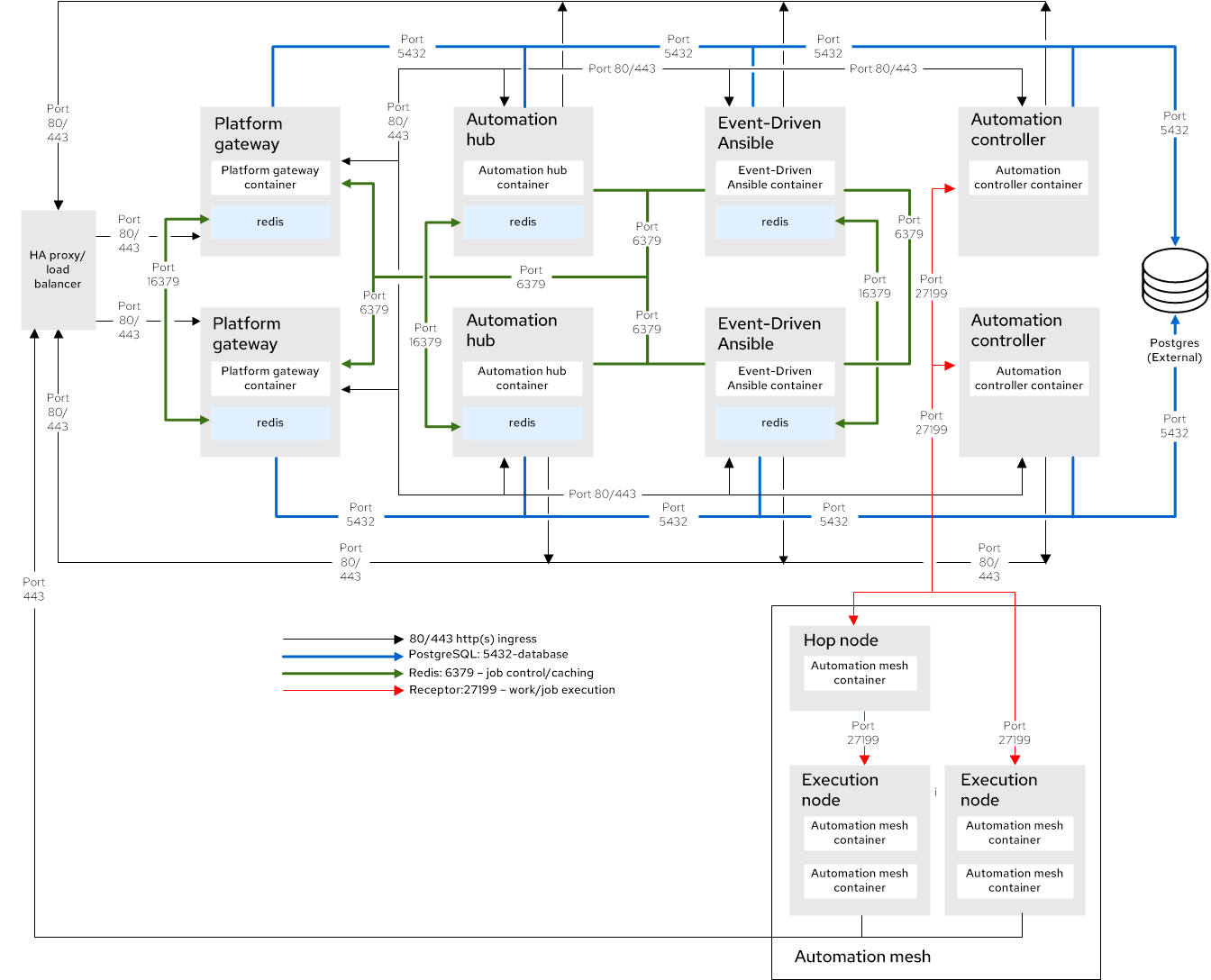3.2. コンテナーエンタープライズトポロジー
コンテナーベースのエンタープライズトポロジーは、大規模な自動化に冗長性と高度なコンピュートを提供します。テスト済みのインフラストラクチャートポロジー、システム要件、ネットワークポート設定、およびインストール用のインベントリーファイルの例が含まれています。
3.2.1. インフラストラクチャートポロジー
Red Hat はこのデプロイメントモデルに対してインフラストラクチャートポロジーをテストしました。
図3.2 インフラストラクチャートポロジー図
Red Hat は、次の要件に基づいて各仮想マシンをテストします。
| 要件 | 最小要件 |
|---|---|
| RAM | 16 GB |
| CPU | 4 |
| ローカルディスク |
|
| ディスク IOPS | 3000 |
| 仮想マシン数 | 目的 | 仮想マシングループ名の例 |
|---|---|---|
| 2 | プラットフォームゲートウェイおよび併置される Redis |
|
| 2 | Automation Controller |
|
| 2 | Private Automation Hub および併置される Redis |
|
| 2 | Event-Driven Ansible および併置される Redis |
|
| 1 | 自動化メッシュホップノード |
|
| 2 | 自動化メッシュ実行ノード |
|
| 1 | 外部管理データベースサービス | 該当なし |
| 1 | プラットフォームゲートウェイの前にある HAProxy ロードバランサー (外部管理) | 該当なし |
- Redis の高可用性 (HA) 互換デプロイメントには、6 台の仮想マシンが必要です。コンテナー化されたインストーラーを使用して Ansible Automation Platform をインストールする場合は、実行ノードまたは PostgreSQL データベースを除く任意の Ansible Automation Platform コンポーネント仮想マシンに Redis を共存させることができます。また、Redis 専用の仮想マシンが割り当てられる場合もあります。
- 外部 Redis は、コンテナー化された Ansible Automation Platform ではサポートされていません。
3.2.2. テスト済みのシステム構成
Red Hat は、Red Hat Ansible Automation Platform をインストールおよび実行するために、次の設定をテストしました。
| 種類 | 説明 | 注記 |
|---|---|---|
| サブスクリプション |
| |
| オペレーティングシステム |
| |
| CPU アーキテクチャー | x86_64、AArch64、s390x (IBM Z)、ppc64le (IBM Power) | |
|
|
|
|
| ブラウザー | 現在サポートされている Mozilla Firefox または Google Chrome のバージョン。 | |
| データベース | PostgreSQL 15 | 外部 (お客様がサポートする) データベースには、International Components for Unicode (ICU) のサポートが必要です。 |
3.2.3. ネットワークポート
Red Hat Ansible Automation Platform は、サービスとの通信に複数のポートを使用します。Red Hat Ansible Automation Platform が動作するには、これらのポートが開いていて利用できるようにする必要があります。これらのポートが利用可能であり、ファイアウォールによってブロックされていないことを確認してください。
| ポート番号 | プロトコル | サービス | ソース | 送信先 | 説明 |
|---|---|---|---|---|---|
| 80/443 | TCP | HTTP/HTTPS | Event-Driven Ansible | Automation Hub | プルコンテナー決定環境 |
| 80/443 | TCP | HTTP/HTTPS | Event-Driven Ansible | Automation Controller | Automation Controller ジョブを起動します |
| 80/443 | TCP | HTTP/HTTPS | Automation Controller | Automation Hub | コレクションと実行環境イメージをプルする |
| 80/443 | TCP | HTTP/HTTPS | HAProxy ロードバランサー | プラットフォームゲートウェイ | 外部ロードバランサーアクセス |
| 80/443 | TCP | HTTP/HTTPS | プラットフォームゲートウェイ | Automation Controller | Automation Controller 通信へのプラットフォームゲートウェイ |
| 80/443 | TCP | HTTP/HTTPS | プラットフォームゲートウェイ | Automation Hub | Automation Hub 通信へのプラットフォームゲートウェイ |
| 80/443 | TCP | HTTP/HTTPS | プラットフォームゲートウェイ | Event-Driven Ansible | Event-Driven Ansible 通信へのプラットフォームゲートウェイ |
| 5432 | TCP | PostgreSQL | Event-Driven Ansible | 外部データベース | Event-Driven Ansible データベースアクセス |
| 5432 | TCP | PostgreSQL | プラットフォームゲートウェイ | 外部データベース | プラットフォームゲートウェイデータベースアクセス |
| 5432 | TCP | PostgreSQL | Automation Hub | 外部データベース | Automation Hub データベースアクセス |
| 5432 | TCP | PostgreSQL | Automation Controller | 外部データベース | Automation Controller データベースアクセス |
| 6379 | TCP | Redis | Event-Driven Ansible | Redis ノード | Event-Driven Ansible のジョブ起動とデータ保存 |
| 6379 | TCP | Redis | プラットフォームゲートウェイ | Redis ノード | プラットフォームゲートウェイサービスのデータ保存と取得 |
| 16379 | TCP | Redis | Redis ノード | Redis ノード | Redis クラスターバス通信 |
| 27199 | TCP | Receptor | Automation Controller | ホップノードと実行ノード | メッシュノードはコントローラーに直接接続します。ジョブ配布のための双方向通信を可能にします。 |
| 27199 | TCP | Receptor | ホップノード | 実行ノード | メッシュノードはホップノードを介して接続します。どちらの方向でも双方向通信を可能にします。 |
| 8080/8443 | TCP | HTTP/HTTPS | プラットフォームゲートウェイ | Automation Controller |
Automation Controller の NGINX ポート。これらのポートは、 |
| 8081/8444 | TCP | HTTP/HTTPS | プラットフォームゲートウェイ | Automation Hub |
Automation Hub の NGINX ポート。これらのポートは、 |
| 8082/8445 | TCP | HTTP/HTTPS | プラットフォームゲートウェイ | Event-Driven Ansible |
Event-Driven Ansible NGINX ポート。これらのポートは、 |
| 8083/8446 | TCP | HTTP/HTTPS | プラットフォームゲートウェイ | プラットフォームゲートウェイ |
プラットフォームゲートウェイの NGINX ポート。これらのポートは、 |
インベントリー変数を使用してポート値を変更する場合は、インベントリーファイル変数 を参照してすべてのデフォルトのポート値を確認し、ポートの競合がないことを確認してください。
3.2.4. インベントリーファイルの例
インストールを実行するには、サンプルのインベントリーファイルを使用します。
